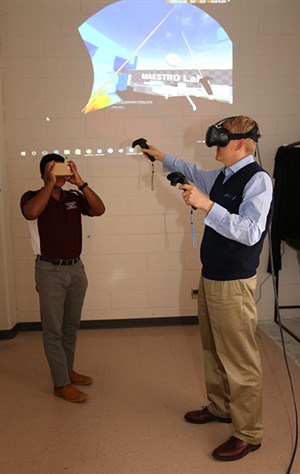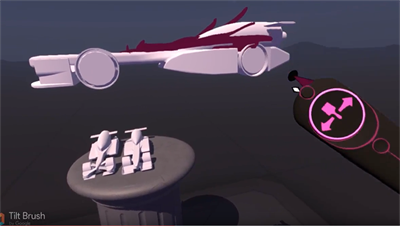Imagine walking into your college classroom and donning a pair of virtual reality goggles to learn the day’s lesson. If Dr. Darren Hartl has his way, that will be a reality in the near future. He is one of the faculty members in the Department of Aerospace Engineering at Texas A&M University bringing virtual reality (VR) into the realm of research and teaching.
Hartl was so excited about the possibilities VR lends to research and teaching that he purchased his setup using startup funds when he joined the faculty as an assistant professor in fall 2016. He also created the Immersive Mechanics Visualization Lab, which is fully dedicated to the tasks and goals of creating immersive and intuitive data environments.
In this lab, faculty and students are developing methods to experience and interface with computational and experimental data across physical fields using augmented reality (AR), VR, and three-dimensional displays (e.g., the ZSpace platform).
 To conduct their research, they use the HTC Vive VR system, along with the ZSpace 3-D monitor. Included in the lab is a screen share and projection system that allows visitors and collaborators to share the VR experience with the individual directly using the HTC Vive.
To conduct their research, they use the HTC Vive VR system, along with the ZSpace 3-D monitor. Included in the lab is a screen share and projection system that allows visitors and collaborators to share the VR experience with the individual directly using the HTC Vive.
Hartl’s current research involves the development of robust methods for translating solid models (such as those from SolidWorks) and finite element models into the VR environment, and for interacting with such models in an intuitive manner.
His objective is to find reasonable ways to take the experimental and computational data faculty and students are already generating and immerse themself in it.
“We have dual-camera systems a few doors down that look at points on a specimen and measure how strain is generated," said Hartl. "Today we can look at those results in complete 3-D on a computer screen and rotate it around. Why can’t I have that same 3-D data in the room with me and walk around the specimen?”
That’s exactly what happened when the SAE Aero Design Team put their model airplane into virtual reality in the lab. Michayal Mathew, an aerospace undergraduate student working with Hartl on this project, was able to see, and then share, actual results from the design they were considering.
Mathew’s job was to find new and different ways to bring computational data into the VR world and then bring the VR world to an increased number of students and collaborators. This summer he will intern with NASA-Godard working on importing topographic data from various NASA Missions (Lunar Reconnaissance Orbiter (LRO) and Mars Reconnaissance Orbiter (MRO)) to create interactive landscapes of actual locations on Earth, the Moon and Mars that can be explored in 3-D using HTC Vive VR headsets.
“For the SAE Design team, we took their model airplane and we brought it in here (in VR)," said Mathew. "Everybody from their team came over and they were just tearing apart their plane looking at the insides. Somebody was like ‘Hey, did y’all know that this piece is out of place?’ And the team was saying, ‘if we had noticed this earlier, we could have redesigned the plane so we wouldn’t have to deal with this error.
“That’s a 3-D SolidWorks model that they’ve seen on the computer a hundred times and no one has noticed the error by just tilting it around on the computer screen," said Mathew. "But they come in here and put it in VR and walk around it and with the controllers, they’re able to manipulate it, move things around, and one guy sticks his head inside the fuselage and notices that there is a piece out of place.”
Students today are technologically savvy. It makes sense to implement VR in education, as it presents complex ideas in a way that’s easy and fun for the students to learn.
Hartl recently worked remotely via WebEx with a group of students from Granbury High School, who are participating in the program F1 in Schools. F1 in Schools is an international STEM competition for school children ages 7-19, in which groups of three to six students design and manufacture a miniature Formula One race car out of the official F1 Model Block using 3-D CAD design tools. They use computational fluid dynamics and wind tunnel testing on their cars to find better ways to aerodynamically streamline their design.
 While in the Immersive Mechanics Visualization Lab, Mathew took the 3-D CAD information from the students and inserted it into the VR world. Dr. Nathan Tichenor, research assistant professor in the department, then “walked around” the car and assessed it for the team in detail. This allowed the students to understand the full 3-D design input from Tichenor while asking him questions in real-time and greatly improving their design.
While in the Immersive Mechanics Visualization Lab, Mathew took the 3-D CAD information from the students and inserted it into the VR world. Dr. Nathan Tichenor, research assistant professor in the department, then “walked around” the car and assessed it for the team in detail. This allowed the students to understand the full 3-D design input from Tichenor while asking him questions in real-time and greatly improving their design.
“Having aerodynamic experts talk to the kids about their car design was helpful, but having them manipulate the car and draw design features virtually took this experience to another level,” said Todd Gibson, faculty advisor to the Granbury team. “Collaboration efforts like these, along with the capabilities that Texas A&M has to offer, really entice my students to make Texas A&M their top choice.”
Hartl hopes to gain two things from this research. First, he wants to determine whether you can accelerate the development of intuition by immersing a person in the data that they have generated. His question is whether his graduate students, who are studying subjects both computationally and experimentally, can increase their intuition about their results better by immersion. He also hopes to learn whether VR can enhance and change solid and fluid mechanics education.
“As I’m figuring out how to teach on a whiteboard and with PowerPoint, why not see if there is place for teaching better with VR,” he said. “In mechanics, we teach obscure and often abstract concepts, such as stress. Stress is a second-order tensor that is represented as a matrix, but it’s a real, physical thing. How do I teach someone this physical quantity that’s represented as a matrix?
“We end up drawing something on a whiteboard and we try to draw it in 3-D or we’ll try to present it on a slide," said Hartl. "Why can’t I draw it in the room with me and show you that the stresses go this way and that way and here is tension and here is shear, and this is all happening at once. Especially as you get to the graduate level, these classes and these topics are so three-dimensional, but we always teach them in 2-D. I asked, ‘is it time to teach them in 3-D?’"
“To be honest, seeing things in 2-D on a whiteboard just doesn’t cut it because almost all our important concepts are three-dimensional,” said Mathew. “So, I have to imagine the third dimension and it just gets to be a lot. But I think if you could show this off, if holograms existed, I think learning mechanics and dynamics would be so much easier.”
One way Hartl hopes to implement VR in the classroom is through the use of affordable viewers such as Google Cardboard. Google Cardboard was developed by Google for use with a head mount for a smartphone. Named for its fold-out cardboard viewer, the platform is intended as a low-cost system to encourage interest and development in VR applications.
Hartl has already demonstrated recording a lesson in VR, then uploading it to YouTube, where students then viewed it in 3-D via cardboard viewers. “Imagine a classroom of students wearing those for some key important lessons where you really needed to get more three-dimensional,” said Hartl.
For more information on Dr. Hartl's Immersive Mechanics Visualization Lab, click here.